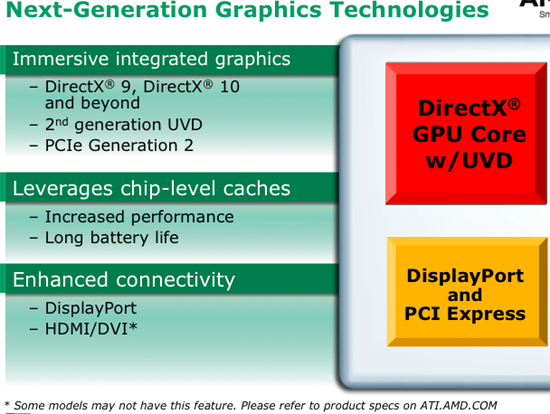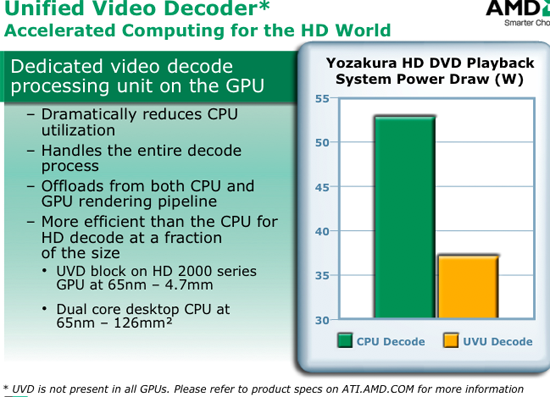Fusion
Remember Fusion? The whole reason for the ATI acquisition? Well, AMD gave us a little more information on its plans for the first Fusion CPUs.The first Fusion CPUs belong to a family of chips codenamed Falcon; note that Falcon refers to the Fusion CPU family and not the CPU or GPU cores themselves. Contrary to popular belief, the first Fusion CPUs will be built of a single die. On this die you will find the following components: a shared memory controller, Bulldozer or Bobcat based CPU cores, a DirectX GPU core with UVD support, a shared cache (shared between the CPU and GPU), and a PCIe controller - all on the same die.

For a one-die solution, the feature list for Falcon is pretty impressive. Let's discuss what we know:
The shared memory controller will most likely support DDR3 given the 2009 - 2010 launch timeframe for Fusion, and obviously it will be used by both the CPU and GPU portions of the die. We've already discussed the Bulldozer and Bobcat cores; you can expect the desktop/notebook Falcon chips to use Bulldozer cores while the smallest Ultra Mobile PCs, high performance smart phones and CE devices to use Bobcat based Falcon processors.

AMD just lists the graphics core as being a "Full DirectX GPU", but fails to attach any DX revision to the support sheet. AMD did mention that the GPU core would be a unified shader architecture, but we suspect that lower end Falcon CPUs may not support everything required by DX9/DX10.

The integrated UVD support will eliminate the need for an external graphics card just to decode high bitrate H.264 video. UVD only ends up being around 4.7 mm^2 of today's 65nm GPU die yet it is several orders of magnitude more efficient than the x86 CPU core at decoding H.264, highlighting the importance of its integration onto the CPU die itself. Given how powerful and efficient UVD is, we can't help but wonder how long it will take for AMD to include it in all of its CPUs. We may have to wait for a unified instruction set between the CPU/GPU before we get that sort of granular integration though.
The last item on the M-Space stack is the on-die PCIe 2.0 controller, which AMD said would support a minimum of 16 lanes externally. With an integrated PCIe controller, the only other chip needed is an external South Bridge that can connect via PCIe to the CPU itself.
The on-die PCIe controller won't kill the add-in GPU market, as you will be able to simply pop in an external graphics card if necessary. You can then either disable the on-die graphics or switch between the two as your usage demands change. In notebooks, AMD expects systems with discrete graphics to swap between it and the on-die GPU on the fly depending on usage.










31 Comments
View All Comments
flashbacck - Thursday, July 26, 2007 - link
Whoever decided those acronyms were necessary should be fired.fzkl - Thursday, July 26, 2007 - link
Like mentioned, the obvious great benefit of having low power x86 chips on mobile phones is the software aspect. PC applications can now run on phones reducing aspirin needs for developers. However, what does this mean in terms of security? Can we see mobile phones needing frequent patches, antivirus, firewalls like in the case of desktops?If this were to be the case we would have successfully made a simple device like the mobile phone(in usage terms) a high maintenance product which a layman might have trouble with.
sheh - Thursday, July 26, 2007 - link
x86 doesn't imply any OS or API. Linux, which is commonly used today on all kinds of devices, can work just as well on x86. Conversely, nothing prevents virus writers from writing viruses for Linux running phones.beyoku - Thursday, July 26, 2007 - link
what happened? Was this article recelty pulled off or something?NDA???
Guuts - Thursday, July 26, 2007 - link
Looks to me like he's trying to get the images working...erwos - Thursday, July 26, 2007 - link
Fusion looks like it'll be a fantastic chip for UMPCs and laptops. Hopefully they'll manage to squeeze more than CPU one core on there, too. Bobcat looks similarly fun - x86 phones! VIA was also discussing this idea, and I could really go for it.That said, AMD is really under-delivering with Barcelona - I suspect the next few years will be pretty rough. Intel has set a low ceiling price for the Barcelonas ($270 - same as the Q6600), and that's not going to be good for AMD's margins.
mlau - Thursday, July 26, 2007 - link
Embedded is ruled by ARM, Freescale, mips and sh derivates; amd and intel are going to have a tough time getting a super-ugly system like pc-x86 (with it's
legacy baggages "bios", "acpi" [you know, the stuff windows requires to run], ...) into that space.
Spoelie - Friday, July 27, 2007 - link
you do not need to have those things to run an x86 cpuloot at EFI for example, in use by apple on their x86 based macs = no more bios.
qpwoei - Sunday, July 29, 2007 - link
The real problem with x86 is that it's inherently not power efficient. To get good x86 performance requires lots of transistors and lots of power due to complex decoders and schedulers. A much simpler architecture like ARM requires very few transistors to run efficiently (at the expense of slightly less compact executable code), and is much more suited for battery-powered devices.Not to say that there won't be x86-powered devices in the future, just that I don't expect them to really gain much of a foothold in any place where battery life is important (eg: phones).
ss284 - Thursday, July 26, 2007 - link
Return of the Jedi